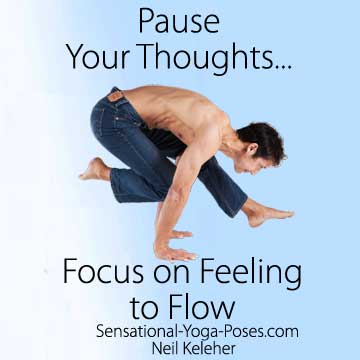Learning to Flow

Flow is a state of consciousness where time seems to stand still.

Flow is a state of consciousness where time seems to stand still.
If you view time as a river, then flow is like being on the river of time. Instead of time flowing past you, it carries you, and so relative to ourselves, time seems to stop.
Another way that flow can be experienced is as if you are watching yourself.
One reason for getting into the flow is that it can feel really really good. You might not notice the feeling while you are in the flow. But afterwards you may find yourself feeling refreshed.
Another reason for getting into the flow is that thinking stops. This doesn't mean that you aren't aware. You just become immersed in what you are doing. There can be a strong sense of "knowing" what you are doing. Decisions come instantly.
Flowing is one of two main modes of consciousness. The other mode is thinking.
Thinking is something that happens inside of our head. It happens in "imaginary space."
The flow is where yoga happens. You could think of it as the state of yoga.
Instead of being isolated in imaginary space, when flowing we take in sensory information.
That information can be from our enrivornment, the world around our body that is directly perceivable.
It can also come from within ourselves.
In flowing mode, the response is instantaneous. It is "pre-thought."
In thinking mode, we might take in a piece of information, think about it, weigh the options and then make a decision on how to act. Thinking tends to introduce a delay between sensing something and responding to it. Sometimes that's a good thing. But not always.
Pre-thinking makes it possible for us to know what to do. It's something we learn and then practice and then improve
Learning to drive is one of my favorite examples of what pre-thinking is.
Initially we don't know how to steer, or change speed. And so we might focus on one thing and learn it to the point that we don't have to think in order to slow down. Instead we realize that we need to slow down and our foot automatically presses on the brake pedal.
This is what I mean by "pre-thought". The knowing of what to do is inside of ourselves.
The same thing happens when learning to touch type. Focusing on a few letters at a time, a few keys, we learn where to press to get a particular letter without having to look. After a few weeks of consistant practice we can type all letters, numbers and punctuation marks without having to look. We can then get on with the act of writing.
And we can gradually work on increasing our typing speed. Or we can make focused efforts to improve our typing speed.
Whether learning to drive or type, we add little units of "muscle memory", "movement patterns" or sub units of consciousness to out own "central" consciousness.
These sub conscious units or ideas have the ability to do themselves.
Part of driving is learning where the controls are so that you can use them. Part of typing is learning where the keys are so that you can hit them reliably.
Learning to use our body, feeling is one of the ways that we can learn where everything is and how everything relates.
When we learn to feel our body, and when we practice both feeling and controlling its elements, then we can make those elements part of our subconsious. Instead of having to think about using our bodies equivalent of the brakes, we can do it subconsciously, meaning we can devote our central consciousness to whatever it is that we are doing.
How then do we learn to feel our body and control it? In much the same way we learn to type or drive a car. Gradually, in isolated elements that we gradually integrate into one cohesive whole.
The better we can feel our body and control it, then the easier it is to focus on what we are doing and flowing.
One reason for learning to feel your body is that you can use it to flow more easily. Because you don't have to think about how to use your body, you can simply use it. You can move it and at the same time you can focus on the sensations that your body generates as they are generated. This then provides an excellent opportunity for you to get out of thinking mode and into flowing mode. The really cool thing is that this can happen even when you are learning your body. The trick, while learning, is focusing on little bits at a time.
Do you need a guide to learning to feel and control your body? How about simple pre-thought exercises that you can get on with doing? With driving lessons for your body (Part of which include the Lessons in muscle control courses you can see at the bottom of this page) the heavy lifting (the thinking) is done for you. You don't have to worry about how to divide the body into smaller elements. It's already done for you. You can then practice learning your body little bits at a time.
These proprioceptive elements are the equivalent of learning the basis of driving a car. They won't make you an expert on your body. They will however give you the foundation for becoming one. And with the clear instructions included with each of the videos in this program, you may find that you begin to get more into the flow because you are focusing on movements and exercises that are easy to feel.
Check out the links at the bottom of the page to find out more.
